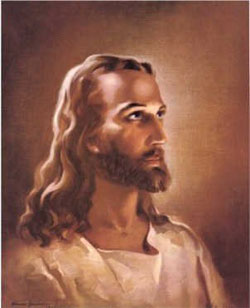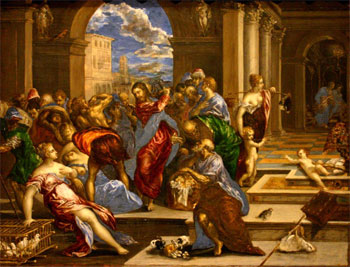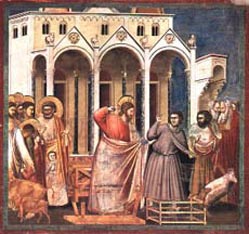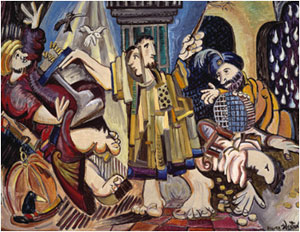Subtle as a Sledge Hammer: Jesus "Cleanses" the Temple
Lent 3B
For Sunday March 19, 2006
Lectionary Readings (Revised Common Lectionary, Year B)
Exodus 20:1–17
Psalm 19
1 Corinthians 1:18–25
John 2:13–22
 |
Sallman's Jesus. |
Think about your earliest memories and images of Jesus. If you are white, American, and Protestant, you might visualize a painting by Warner Sallman, The Head of Christ (1940)—Jesus with flowing blond hair and saccharine blue eyes. Sallman's Jesus, reproduced 500 million times according to one estimate, stares into space. He is clean, safe, passive, and effeminate, which is perhaps why Christians have plastered this image in many a child's Sunday school room. It's hard to fathom why such a harmless and respectable looking citizen would ever be arrested, beaten to a pulp, and crucified by establishment authorities; he wouldn't hurt a flea.
Sallman's painting illustrates how easily we domesticate the deity, creating Jesus in our own image so that we can then co-opt him for our own purposes. The reading this week from John's Gospel challenges all such self-serving projections. The "cleansing" of the temple, a delicate euphemism to describe the only violent act of Jesus, occurs in all four Gospels. It is an unnerving story that reminds us that there is no such thing as "business as usual" with Jesus, and that all who come to him must come on his terms, not ours.
 |
Christ Cleansing the Temple, El Greco, c. 1570. |
All three synoptic writers situate this story at the end of Jesus's ministry, sandwiching it between his triumphal entry into Jerusalem and the parable of the tenants (Mark 11:15–18 = Matthew 21:12–17 = Luke 19:45–48). John places the story at the beginning of Jesus's ministry, in my Bible on the third page of his gospel, where except for the wedding at Cana it looms as Jesus's first public act. Maybe there was more than one temple cleansing, but given the radical nature of the act that seems improbable. The verbatim literary similarities in all four Gospel accounts, and the fact that John mentions three or even four distinct Passovers (2:13, 6:4, 11:55, and 5:1), signal that John cares more about theological confession than chronological precision.
As an observant Jew, Jesus joined the throngs of pilgrims who trekked to Jerusalem to celebrate the Passover at the temple. According to the Jewish historian Josephus (Antiquities XV, 380 and XX, 219), construction on the temple began in 20 BC under Herod the Great, and was completed by Herod Agrippa around AD 63. A bustling nexus of commercial activity, crowds of worshippers, nationalist aspirations, political identity, historical memory, architectural splendor, and of religious affiliation, the temple constituted the essence of Jewish faith in both a literal and symbolic manner.
 |
Cleansing of the Temple, Giotto Bordone (1276–1336) |
When Jesus entered the temple he encountered men selling cattle, sheep and doves to the pilgrims who needed them to make their obligatory sacrifices. They also needed to exchange their Roman currency into Jewish money in order to pay the temple tax in the coinage of the "sanctuary shekel" (see Exodus 30:11–16), and thus we read that Jesus also met the money changers. Then all hell broke loose. Incensed at the sacrilege of it all, Jesus improvised a whip, thrashed the animals from the temple, scattered the coffers of the money changers, and overturned their tables: "How dare you turn my Father's house into a market!" Later his disciples remembered Psalm 69:9 and attached a sense of prophetic fulfillment to the event: "Zeal for your house will consume me."
It's not clear whether Jesus objected to any and all commercial activity in the temple out of principle, even honest transactions that were necessary for pilgrims to fulfill their religious obligations, or whether he excoriated the fraud, exploitation and avarice of the religious authorities who controlled the means of ritual purity and thus access to Yahweh. When asked to justify his violent actions with a sign, Jesus refused; instead of any interpretation, justification or explanation, he responded with an enigmatic saying: "Destroy this temple, and I will raise it again in three days." Long after the event, his disciples interpreted Jesus's dark saying as a prediction of his death and resurrection.
In his dramatic outburst Jesus joined a violent act with an enigmatic saying that has elicited several layers of interpretation. A few people see a prophetic prediction of the destruction of the temple that occurred in 70 AD. A simpler interpretation understands the story as a restoration or purification of the temple to its sacred purpose, as a place of prayer for all people, without manipulation or exploitation by the establishment gatekeepers. A third nuance suggests that in his own body, in his own impending death and resurrection that John mentions on the first pages of his gospel, Jesus fulfills all the functions of the temple building as the place to meet God. To be sure, in the words of the British New Testament scholar C.K. Barrett, here as in all of John's Gospel we are to understand that "in Jesus the eternal purposes of God find their fulfillment."
No doubt the disciples tossed and turned a long, sleepless night that evening; it must have been terribly disconcerting to witness Jesus unhinged, throwing furniture, screaming at the top of his lungs, and flinging money into the air. Perhaps they ran for cover with the crowd. I would have. Did they look him in the eyes the next morning, or shuffle their feet, stare at the ground, and make small talk? I liken their experience to the "crazy uncle" syndrome—who could predict the next outrageous act or violent outburst?
 |
Jesus Cleansing the Temple, Jeffrey Weston. |
I read the cleansing of the temple as a stark warning against any and every false sense of security. Misplaced allegiances, religious presumption, pathetic excuses, smug self-satisfaction, spiritual complacency, nationalist zeal, political idolatry, and economic greed in the name of God are only some of the tables that Jesus would overturn in his own day and in ours. Church is more than a place to enjoy a night of bingo or to reinforce my many prejudices and illusions. Thank God, then, for the Psalm for this week which concludes with a prayer that is wonderfully appropriate this Lenten season: "Who can discern his errors? Forgive my hidden faults. Keep your servant from willful sins; may they not rule over me...May the words of my mouth and the meditation of my heart be pleasing in your sight, O Lord, my Rock and my Redeemer" (Psalm 19:12–14).
For further reflection:
* How and why have we "domesticated" Jesus into a meek-n-mild savior?
* To what extent did Jesus use violence in cleansing the temple?
* Consider how some of our deepest religious impulses and places (in this story the Temple) lead us astray.
* How might we avoid all forms of false religious security?
* Consider the ways we "sanitize" the Jesus story.





